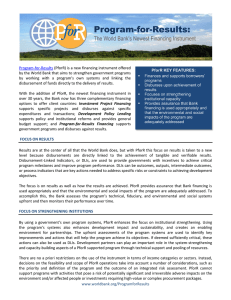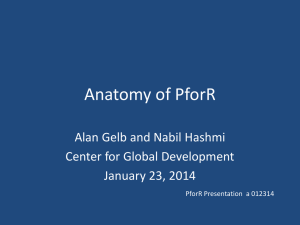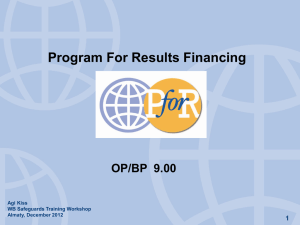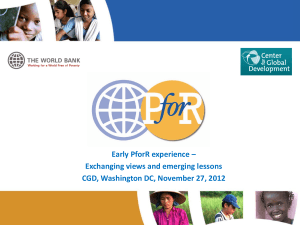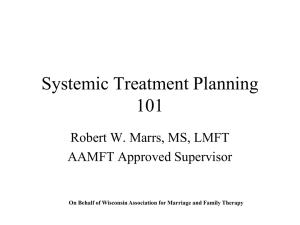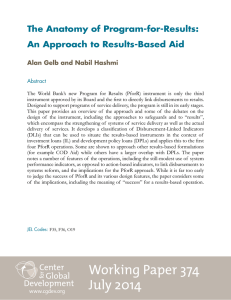Ethiopia presentation - International Health Partnership
advertisement
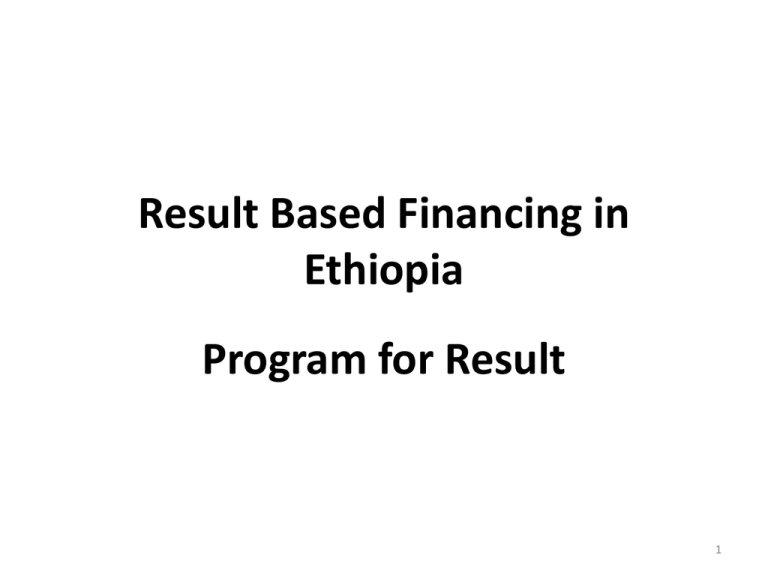
Result Based Financing in Ethiopia Program for Result 1 Background • The new Program for Results (PforR) financing instrument is a new lending mechanism which was applied since 2013 in the Ethiopian Health sector • The PforR instrument makes the Bank’s contribution more responsive to present needs in Ethiopia • Disbursement is based on achievement of eight agreed upon DLIs • The achievement of these DLIs are measured at national level not sub-national level 2 Background • The program development objective (PDO) is to improve the delivery and use of a comprehensive package of maternal and child health services. • The PDO is a subset of the strategic objectives of HSDP IV that focus on improving access to health services and evidence-based decision making by harmonization and alignment 3 Scope of the program • The fund from PforR operation will support activities under the MDGPF with exception of the high-value procurement • The MDGPF has supported financing gaps in maternal health, child health, capacity building of health extension workers and strengthening of health systems such as HR, Construction and equipping of health facilities. 4 Key program results for PforR – (i) antenatal coverage (%); – (ii) deliveries attended by skilled health providers (%); – (iii) Pentavalent 3 vaccine coverage for children aged 12-23 months (%); and – (iv) contraceptive prevalence rate (%). 5 DLIs DLI Verification mechanism Deliveries attended by skilled birth providers (%) Mini DHS, DHS Children 12-23 months immunized with Pentavalent 3 vaccine (%) Cluster survey (twice during the project period) Pregnant women receiving at least one antenatal care visit Mini DHS, DHS Contraceptive Prevalence Rate (%) Mini DHS, DHS Health Centers reporting HMIS data in time RDQA (every six months) Development and implementation of Balanced Score card approach to assess facility performance and related institutional incentives Separate implementation report Development and implementation of Annual Rapid Facility Assessment to assess readiness to provide quality MNCH services SPA, SARA (Survey reports) Improved transparency of the Pharmaceutical Fund and Supply Agency (PFSA) Independent consultant report 6 Question 1 • Are the current and proposed P4R schemes well aligned with national strategic plan and its targets and indicators? – PforR is aligned with national strategic plan and targets because once it is disbursed it is managed as per the JFA which bases its plans on the strategic documents. The targets for PforR are set based on the national strategic documents. 7 Question 2 • What have been the challenges in getting them aligned? – The challenges are the fact that PforR uses parallel verification mechanism and the sector needs to coordinate or fund those verification systems – The high value procurement is not allowed so the PforR fund is put in a sub account – There are numerous POA to be followed up and these require a lot of time and energy 8 Question 3 • Have P4R schemes been designed to strengthen and increase use of national systems, especially reporting and information systems? How have demands for monitoring and verification been managed? – Yes the PforR uses the government system to plan, implement and report. The only addition is that it has separate triggering mechanism to ensure disbursement. – The verification mechanisms are demanding, resource intensive and put a lot of burden on the government system. – MOH negotiated with CSA and EPHI to work on the miniDHS and also the facility survey (SPA+) 9
